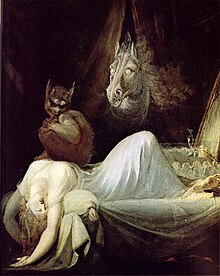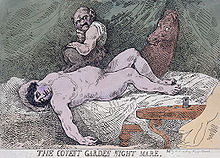A nightmare, also known as a bad dream, is an unpleasant dream that can cause a strong emotional response from the mind, typically fear but also despair, anxiety, disgust or sadness. The dream may contain situations of discomfort, psychological or physical terror, or panic. After a nightmare, a person will often awaken in a state of distress and may be unable to return to sleep for a short period of time. Recurrent nightmares may require medical help, as they can interfere with sleeping patterns and cause insomnia.

Henry Fuseli was a Swiss painter, draughtsman, and writer on art who spent much of his life in Britain. Many of his works depict supernatural experiences, such as The Nightmare. He painted works for John Boydell's Shakespeare Gallery and created his own "Milton Gallery". He held the posts of Professor of Painting and Keeper at the Royal Academy. His style had a considerable influence on many younger British artists, including William Blake.
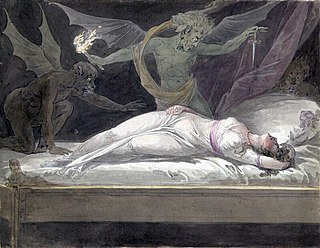
An incubus is a demon in male form in folklore that seeks to have sexual intercourse with sleeping women; the corresponding spirit in female form is called a succubus. Parallels exist in many cultures.
Queen Mab is a fairy referred to in William Shakespeare's play Romeo and Juliet, where "she is the fairies' midwife". Later, she appears in other poetry and literature, and in various guises in drama and cinema. In the play, her activity is described in a famous speech by Mercutio published originally in prose and often adapted into iambic pentameter, in which she is a miniature creature who performs midnight pranks upon sleepers. Being driven by a team of atomies, she rides her chariot over their noses and "delivers the fancies of sleeping men". She is also described as a midwife to help sleepers "give birth" to their dreams. Later depictions have typically portrayed her as the Queen of the Fairies.
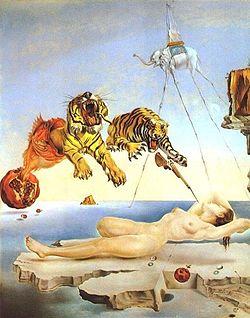
Dream Caused by the Flight of a Bee Around a Pomegranate a Second Before Awakening is a surrealist painting by Salvador Dalí. A shorter alternate title for the painting is Dream Caused by the Flight of a Bee. It was painted in 1944, and the woman in the painting, dreaming, is said to represent his wife, Gala. The painting is currently in the Thyssen-Bornemisza Museum, in Madrid.
A nightmare is a frightening dream.
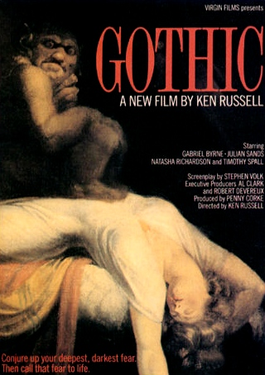
Gothic is a 1986 British psychological horror film directed by Ken Russell, starring Gabriel Byrne as Lord Byron, Julian Sands as Percy Bysshe Shelley, Natasha Richardson as Mary Shelley, Myriam Cyr as Claire Clairmont and Timothy Spall as Dr. John William Polidori. It features a soundtrack by Thomas Dolby, and marks Richardson's and Cyr's film debut.

A mare is a malicious entity in Germanic and Slavic folklore that walks on people's chests while they sleep, bringing on nightmares.

Dark Romanticism is a literary sub-genre of Romanticism, reflecting popular fascination with the irrational, the demonic and the grotesque. Often conflated with Gothic fiction, it has shadowed the euphoric Romantic movement ever since its 18th-century beginnings. Edgar Allan Poe is often celebrated as one of the supreme exponents of the tradition. Dark Romanticism focuses on human fallibility, self-destruction, judgement, punishment, as well as the psychological effects of guilt and sin.

An Alp is a supernatural being in German folklore.

Incubus is a 2006 horror thriller film by Sony Pictures Home Entertainment that was directed by Anya Camilleri and stars actress Tara Reid. The film was released on May 3, 2006 and had an internet premiere on AOL during Halloween 2006. An unrated version was released to DVD on February 6, 2007. The film has billed itself as the first Download To Own video.
The Batibat is a vengeful demon found in Ilocano folklore. In Tagalog folklore, the creature is called Bangungot. The batibat takes the form of an ancient, grotesquely obese, tree-dwelling female spirit. They usually come in contact with humans when the trees in which they reside are felled and are made homeless, especially when their tree is made into a support post for a house. This causes them to migrate and inhabit what is left of their tree. The batibat forbids humans from sleeping near its post. When a person does sleep near it, the batibat transforms into its true form and attacks the person by suffocating their victim and invading their dream space, causing sleep paralysis and waking nightmares. This condition lends itself to the Ilocano word for nightmare, "batíbat". To ward off the batibat, one should bite one's thumb or wiggle one's toes. In this way, the person will awaken from the nightmare induced by the batibat.

Frankenstein; or, The Modern Prometheus is an 1818 novel written by English author Mary Shelley. Frankenstein tells the story of Victor Frankenstein, a young scientist who creates a sapient creature in an unorthodox scientific experiment. Shelley started writing the story when she was 18, and the first edition was published anonymously in London on 1 January 1818, when she was 20. Her name first appeared in the second edition, which was published in Paris in 1821.

A hag is a wizened old woman, or a kind of fairy or goddess having the appearance of such a woman, often found in folklore and children's tales such as "Hansel and Gretel". Hags are often seen as malevolent, but may also be one of the chosen forms of shapeshifting deities, such as The Morrígan or Badb, who are seen as neither wholly benevolent nor malevolent.

Ephialtes is an anxiety disorder identified as such by John Bond in 1753, along with other authors of those times, in his treatise "An Essay on the Incubus, or Nightmare". The famous Greek physician Galen in the 2nd century AD had already named nightmares "Ephialtes". Throughout history, sleep paralysis and the similar term nightmare have been widely accompanied by mythological creatures with paranormal powers.

The Bride of Frankenstein is a fictional character first introduced in Mary Shelley's 1818 novel Frankenstein; or, The Modern Prometheus and later in the 1935 film Bride of Frankenstein. In the film, the Bride is played by Elsa Lanchester. The character's design in the film features a conical hairdo with white lightning-trace streaks on each side, which has become an iconic symbol of both the character and the film.

The night hag or old hag is the name given to a supernatural creature, commonly associated with the phenomenon of sleep paralysis. It is a phenomenon which a person feels during a presence of a supernatural malevolent being which immobilizes the person as if sitting on their chest or the foot of their bed. The word "night-mare" or "nightmare" was used to describe this phenomenon before the word received its modern, more general meaning. Various cultures have various names for this phenomenon and supernatural character.

Version No. 2 of Lying Figure with Hypodermic Syringe is a 1968 oil-on-canvas painting by the Irish-born, English artist Francis Bacon. It is the second of two similarly titled paintings based on nude photographs of his close friend Henrietta Moraes, who is shown in a reclining position on a bed, themselves part of a wider series of collapsed figures on beds that began with the 1963 triptych Lying Figure. This later version is widely considered the more successful of the two panels.
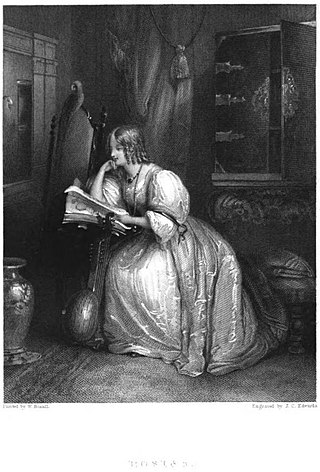
The Invisible Girl is a Gothic tale written by Mary Shelley and first published in The Keepsake for 1833. The tale is set in Wales, and tells the story of a young woman named Rosina, who lives with her guardian, Sir Peter Vernon, and is secretly engaged to his son, Henry. Henry is away from home when their relationship is discovered, and Sir Peter casts Rosina out of the house. Sir Peter regrets his harshness and searches for her, but assumes she is dead when she cannot be found. Henry returns home to the news of Rosina's death and is heartbroken. He joins the search for her body, and the villagers tell him about the Invisible Girl, a ghostly figure who wanders the woods at night. Henry finds Rosina hiding in a remote ruin and discovers that she is really the Invisible Girl. Sir Peter forgives them for their secret engagement, and they are married.

Titania and Bottom is an oil painting by the Anglo-Swiss painter Henry Fuseli. It dates to around 1790 and is displayed at Tate Britain, in London. It was commissioned for the Boydell Shakespeare Gallery and depicts a scene from A Midsummer Night's Dream by William Shakespeare.


